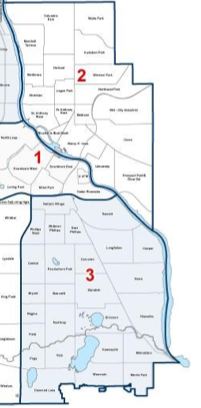Our speaker was Sgt. Molly Fischer, who joined the Minneapolis Mounted Police in 2001. She became Sgt. two years ago, and leads the division.
Although there are pictures of Mpls police on horseback that look like they go back 100 years, that unit was disbanded long ago. The current division was established in 1994, briefly disbanded and then re-established in 1996 with four riders and three horses. Since then the team has grown to 12 horses, three full time staff (down one due to retirement). 22 officers are fully certified Mounted Police.
Training the officers: Only sworn MPD officers are interviewed for training They finish a 6 week basic mounted police course and attend a monthly refresher. Special training events are scheduled as needed. Officer Fischer assured us that 5 hours a day in the saddle for new riders is demanding. This is a pass/fail training that takes place at the Zuhrah Shrine Ranch located in Maple Plain, Minnesota, which is where the animals are housed. Only 30-35% of all applicants are experienced with horses.
Common duties include downtown and Dinkytown bar/restaurant closing on Friday and Saturday nights, crowd control at sporting events and other scheduled events, public relations events like National Night Out, parades, and the MPD open house events, disaster call outs like the Northside tornado, and regular patrols in problem areas. Every kind of duty is different and requires different training.
When and why is the mounted police team so effective:
–Horses are large enough to be intimidating. Because of their size and their training, they move crowds without human force. In an escalating situation, horses can separate groups of people whose energy is building and substantially diffuse a situation.
–Horses offer their riders a visual advantage. Riders are literally 10 feet tall and can see what’s going on in a crowd while officers on foot can only see the people immediately around them. For the same reason, and officer on horseback has an advantage when she needs to direct traffic. Later in the meeting, Inspector Waite stated that by her observation, one horse and rider can do the work of as many as 12 officers on foot–they are that effective with crowds.
–Horses are great community relations ambassadors: people who walk away from officers on foot or in a squad, will stay and even come closer. Officer Fischer mentioned that she’s used horses to bring kids into a helpful situation, citing a group of several young teens on skateboards (looking for something to do). She asked them to help the horses get used to the sound of boards on pavement. The youth boarded past and then around the animals to help them become accustomed to the noise (which the horses must do) and the kids felt good about helping the horses. This year the patrol offered an urban trail ride which was very well received and will likely be repeated–horse lovers, watch for it!.
What horses do they want, and how do they get them:
The patrol is looking for geldings and mares, at least 15.3 hands high, with good conformation, calm & friendly to people and to other horses, and with good trailer habits. Sgt. Fischer prefers draft horses and crosses because they are quite happy to stand around all day, which hunters or jumpers wouldn’t like. Right now the animals average about 16.1-16.2 hands (about 5’5″ at the withers–the base of the neck) All horse candidates get a very thorough vet check and are on trial for 60-90 days. (An exception: one horse who couldn’t settle in just got rejected after a 2 year trial.)
Officers are preparing for school vacations: U of MN is out 3/14 – 3/18; Mpls Public Schools are on break from March 28 through April 1. It’s also time to prepare for the U of MN Spring Jam at the end of April.
Future PAC topics include our award winning MPRB, traffic control and traffic laws enforcement, Minneapolis Regulatory Services, and more……
Emilie note: If you have a traffic law enforcement concern that you can track, please let me know OFFLIST. I’ll pass them along to the officers who will be speaking on traffic issues so they know what our concerns are. Complaints that start with “This morning at 9AM I counted…” are good. Complaints that start with “I think” probably can’t be addressed.


